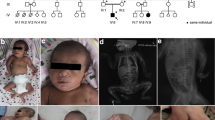Abstract.
A dominant induced mutation in the mouse, tightly associated with a reciprocal chromosomal translocation between Chrs 4 and 17, causes abnormal head tossing and circling behavior (the translocation induced circling mutation, Tim). Affected mice develop an unusual anterior subcapsular cataract that appears after birth and is progressive. The most likely explanation for the phenotypic observations is that the translocation breakpoint disrupted a gene or its regulation. Although the Mos protooncogene is located close to the translocation breakpoint and transgenic mice that overexpress Mos demonstrate cataracts and circling behavior, there were no gross changes in the Mos gene or in its level of expression. The morphological changes observed in the lens resemble those seen in some human congenital cataract syndromes.
Similar content being viewed by others
Author information
Authors and Affiliations
Additional information
Received: 31 July 1998 / Accepted: 14 October 1998
Rights and permissions
About this article
Cite this article
Smith, R., Johnson, K., Hawes, N. et al. Lens epithelial proliferation cataract in segmental trisomy involving mouse Chromosomes 4 and 17. 10, 102–106 (1999). https://doi.org/10.1007/s003359900952
Issue Date:
DOI: https://doi.org/10.1007/s003359900952




